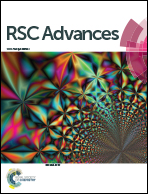Preparation of chemical staple fibers by plasticizing bleached coniferous pulps with 1-allyl-3-methylimidazolium chloride
Abstract
In this study, we prepared chemical staple fibers (CSFs) by plasticizing bleached coniferous pulps (BCPs) with 1-allyl-3-methylimidazolium chloride (AMIMCl) under high temperature and pressure. It became a transparent paper after hot-pressing when the mass ratio of AMIMCl to BCPs was 4 : 5. Interestingly, it could be hot-pressed into a new transparent paper after the transparent paper prepared above was torn into pieces. The morphologies of fibers showed that BCPs could be plasticized with AMIMCl. The glass transition temperature (Tg) occurred in CSFs when the mass ratio of AMIMCl to BCPs was 4 : 5 and the corresponding temperature was 149 °C, which was lower than the initial decomposition temperature, therefore, CSFs could achieve workability to a certain extent. The plasticizing effect of AMIMCl on BCPs was further verified by testing the properties of the paper. The plasticizing effects of 1-butyl-3-methylimidazolium chloride (BMIMCl) and 1-ethyl-3-methylimidazolium acetate (EMIMAc) on BCPs showed the universality of the method for preparing CSFs with AMIMCl.



 Please wait while we load your content...
Please wait while we load your content...